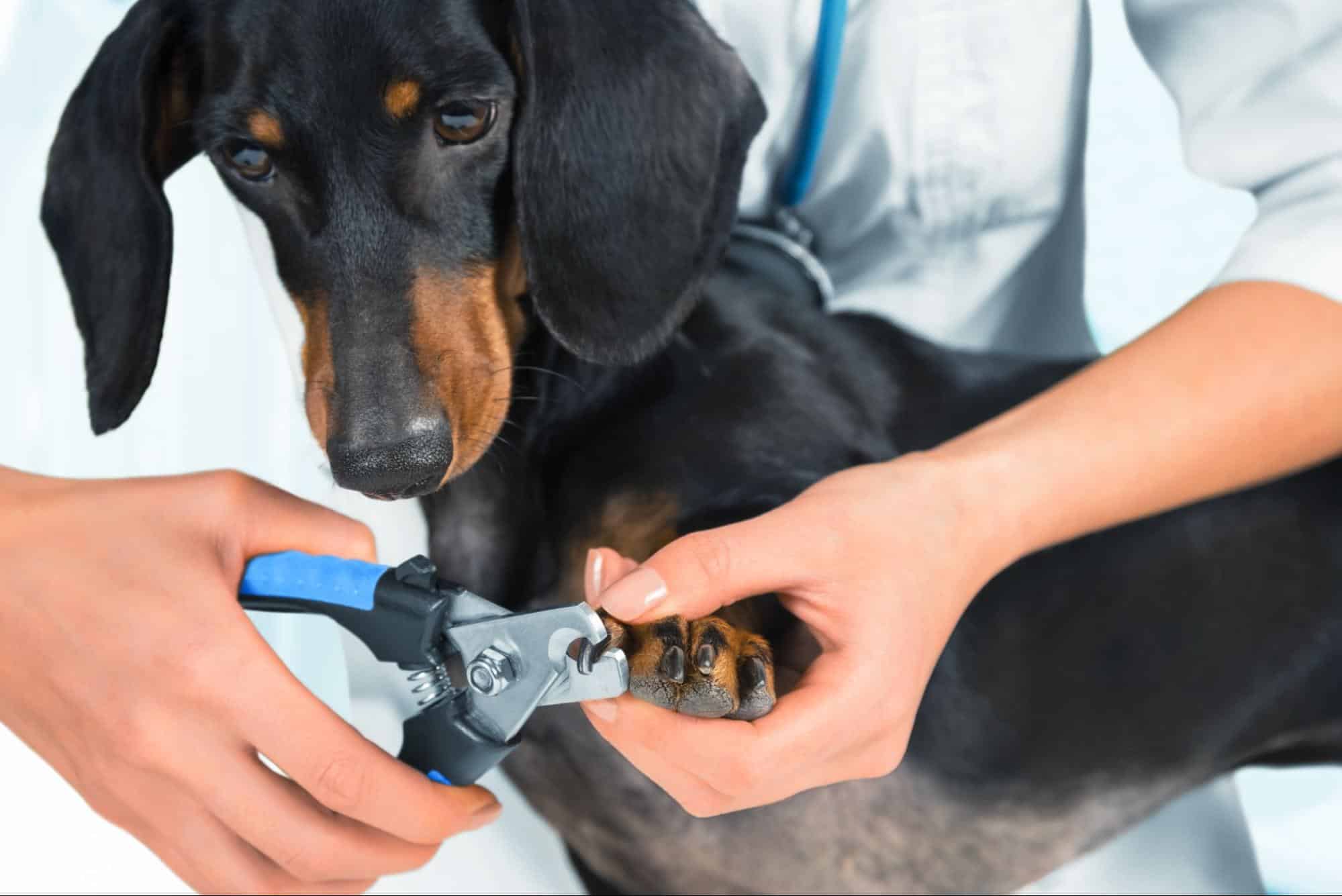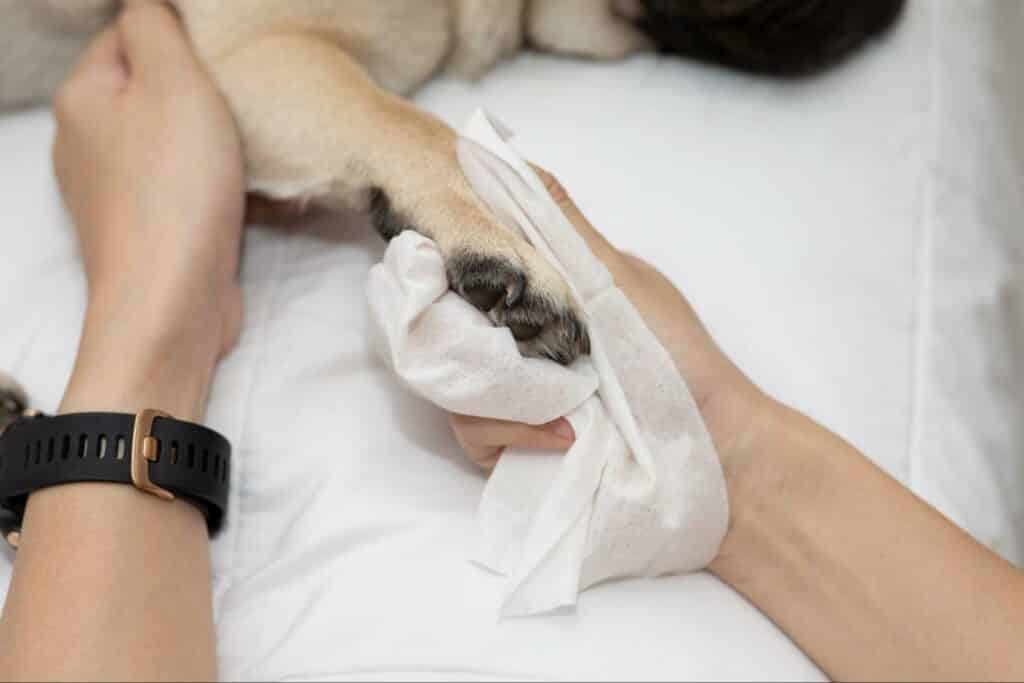If your dog has a broken toenail, there’s no need to panic. It’s a fairly common injury that can happen for various reasons. The most important thing is to determine if your dog needs to see a vet. If the broken nail is causing your dog pain or bleeding excessively, then it’s best to err on the side of caution and make an appointment with your veterinarian. However, if the break is minor and your dog isn’t uncomfortable, you can likely treat it at home.

What are Broken Nails in Dogs?
While most dog owners have likely seen their pet with a broken nail, they may not know what causes this common injury. Several things can contribute to this, including trauma, infection, and overgrowth.
Trauma is the most common cause of broken nails in dogs, and it can occur from accidentally hitting the nail on a door to getting caught on something while running.
Infections and overgrowth can also weaken the nail, making it more susceptible to breakage. If you notice your dog has a broken nail, it’s essential to take them to the vet so that the cause can be diagnosed and treated appropriately. Untreated broken nails can lead to pain, bleeding, and other serious complications.
Minor Nail Breaks
If your dog breaks a nail and there’s some mild bleeding, it can be treated at home by applying pressure with a gauze or clean cloth on the injured area until any more redness goes away. You should hold this for 5-10 minutes without peeking before checking again to ensure the bleeding has stopped.
Major Nail Breaks
Nails that are still attached but are cracked, painful, and bleeding should be seen by a veterinarian. The doctor will typically use some form of sedation and pain medication to treat these stubborn injuries. They may also cut off the damaged nail just above where it cracks, allowing them to access deep within the skin easily!
What Causes My Dog's Toenails to Break?
Most dog owners have experienced the frustration of dealing with a broken nail. These seemingly innocuous injuries can be pretty painful for our furry friends and lead to more severe infections if not treated properly. So why do dogs’ nails break?
There are several possible causes. One is trauma, which can occur if your dog hits his nail on something hard or gets it caught in something. Another common cause is overgrowth. When nails get too long, they become weak and brittle, making them more susceptible to breaking. Finally, certain health conditions, such as cancer, can make nails more fragile and prone to injury.
However, the most common is when pet owners trim the nail too short. If you’re concerned about your dog’s nails, talk to your veterinarian to find the best way to keep them healthy and strong.

Why Is It Important to Avoid Broken Nails?
Anyone who has ever had a dog knows that they are not the most gentle creatures. They love to play and run around, so their nails constantly get scratched and chipped. While this may not seem a big deal, broken nails can be quite dangerous for dogs. The blood vessel inside the nail can quickly become exposed when broken.
This not only causes pain for the dog but can also lead to infection. In addition, broken nails can get caught on things, which can tear the nail bed and lead to even more pain. For these reasons, it is important to avoid broken nails in dogs by keeping them trimmed and filed regularly. Taking these simple precautions can help keep your furry friend healthy and happy.
How to Prevent Broken Toenails
Dogs love to play, but scratching and digging can take a toll on their nails. If not correctly cared for, nails can become dry, brittle, and cracked, leading to pain and infection. The good news is that you can do a few simple things to help keep your dog’s nails healthy and strong.
Keep Your Dog's Nails Short
One of the main ways you can prevent your dog’s nails from breaking is by keeping them trimmed regularly. You’ll want to use a sharp nail trimmer designed specifically for dogs and avoid cutting too close to the quick (the pink area in the center of the nail where blood vessels and nerves are located). In addition, it’s essential to file your dog’s nails after trimming them to help keep the edges smooth.
Ask Your Vet to Show You to Trim Your Dog's Nails
Trimming your pup’s toenails may seem daunting, but your vet can show you the proper way to do it. Avoiding overgrown toenails is vital for your pup’s health and well-being. With a bit of practice, you’ll be able to keep your furry friend’s nails looking neat.
Monitor Your Pup's Paws Regularly
It’s essential to check your dog’s nails and paw pads regularly, and this will help keep them healthy and safe. If you’re unsure how to do this, ask your veterinarian or groomer for help.
First Aid for Broken Toenails
Restrain Your Pup
Have someone hold your furry friend while you tend the wounds on his nails because even the nicest pets may bite when in pain. A muzzle might help avoid any bites from happening while you are inspecting the injury.
Gently Stop the Bleeding
Wrap the injured paw with gauze or a towel and apply gentle pressure. If the bleeding does not stop in 5-10 minutes, you can try using a silver nitrate stick, styptic pencil, or cauterizing powder to the nail. The first aid section of a drug store or pet store sells these items that are a great addition to your emergency kit. Cover the injured nail with flour or baking powder if you don’t have any of these on hand.
Remove the Damaged Piece of Toenail
If you notice a tiny sliver of the nail that you can safely remove at home, go ahead and do so. However, keep the paw wrapped with gauze for more difficult injuries and head to the vet.
Keep an Eye Out for Infection
Because the nail bed is attached to the bone, it is essential to keep the infection from spreading. You will need to monitor the injury closely, and your veterinarian will likely schedule a follow-up appointment to examine the nail and possibly change the dressing. Oral or topical antibiotics might be prescribed to aid in the healing process.
How to Stop Bleeding When You Accidentally Cut Too Far Into Your Dog's Nail
Anyone who has ever cut their dog’s nails knows it can be a delicate task. The nails are thick and hard, and it is easy to cut too far and cause the quick to bleed accidentally. If this happens, don’t panic. Follow these steps to help your pup heal.
Pack the End of the Nail With a Coagulant
To stop the bleeding from a nail that has been trimmed too closely or broken off, you can pack it with bar soap and other ingredients like styptic powder or tea bags. Hold this up against the skin’s breakage for at least one minute before releasing pressure to ensure all of its coagulants get into the sore.
Keep Your Dog Still
You may need to enlist help to keep your dog still while you examine the injury. However, even with help, it can be challenging to maintain a pup from moving around too much. So, while examining the wound, take breaks and give your dog a chance to move around a bit.
Check Paws for Any Infection
Be sure to check the wound frequently for signs of infection. If you notice any redness, swelling, or pus, these could be signs that the infection is spreading. Seek medical attention immediately if you think your dog has an infection, as it can cause further complications.










